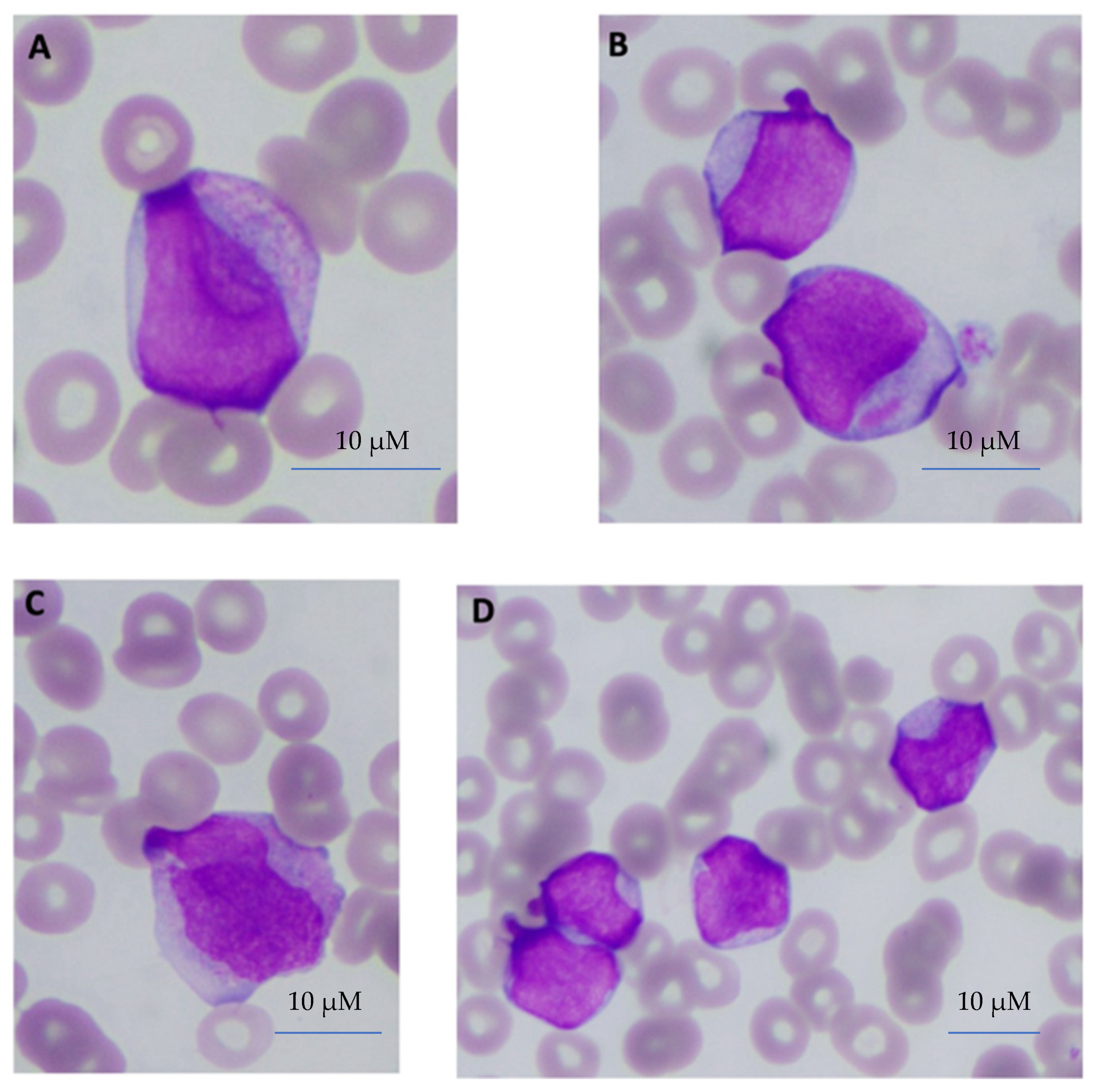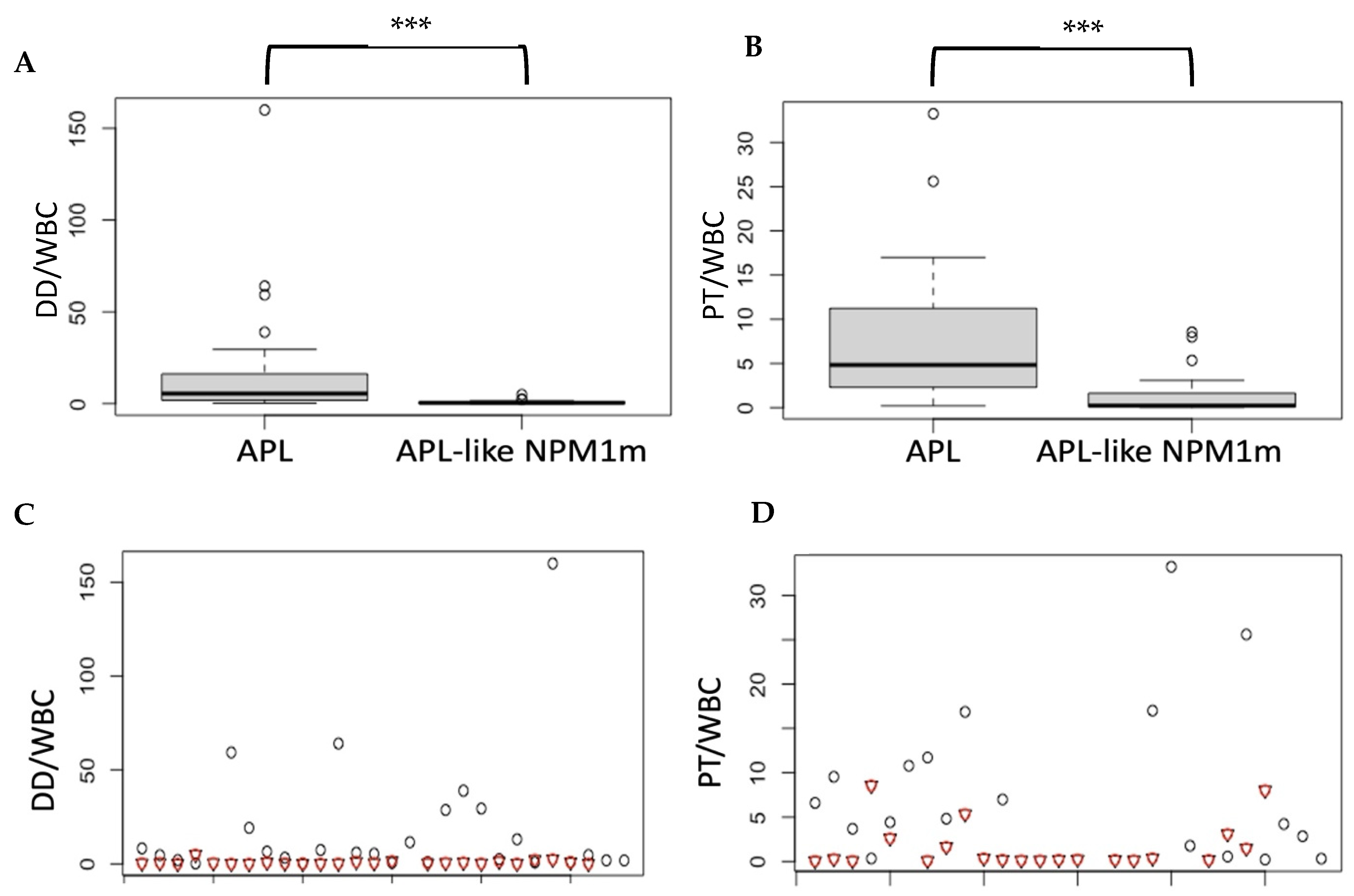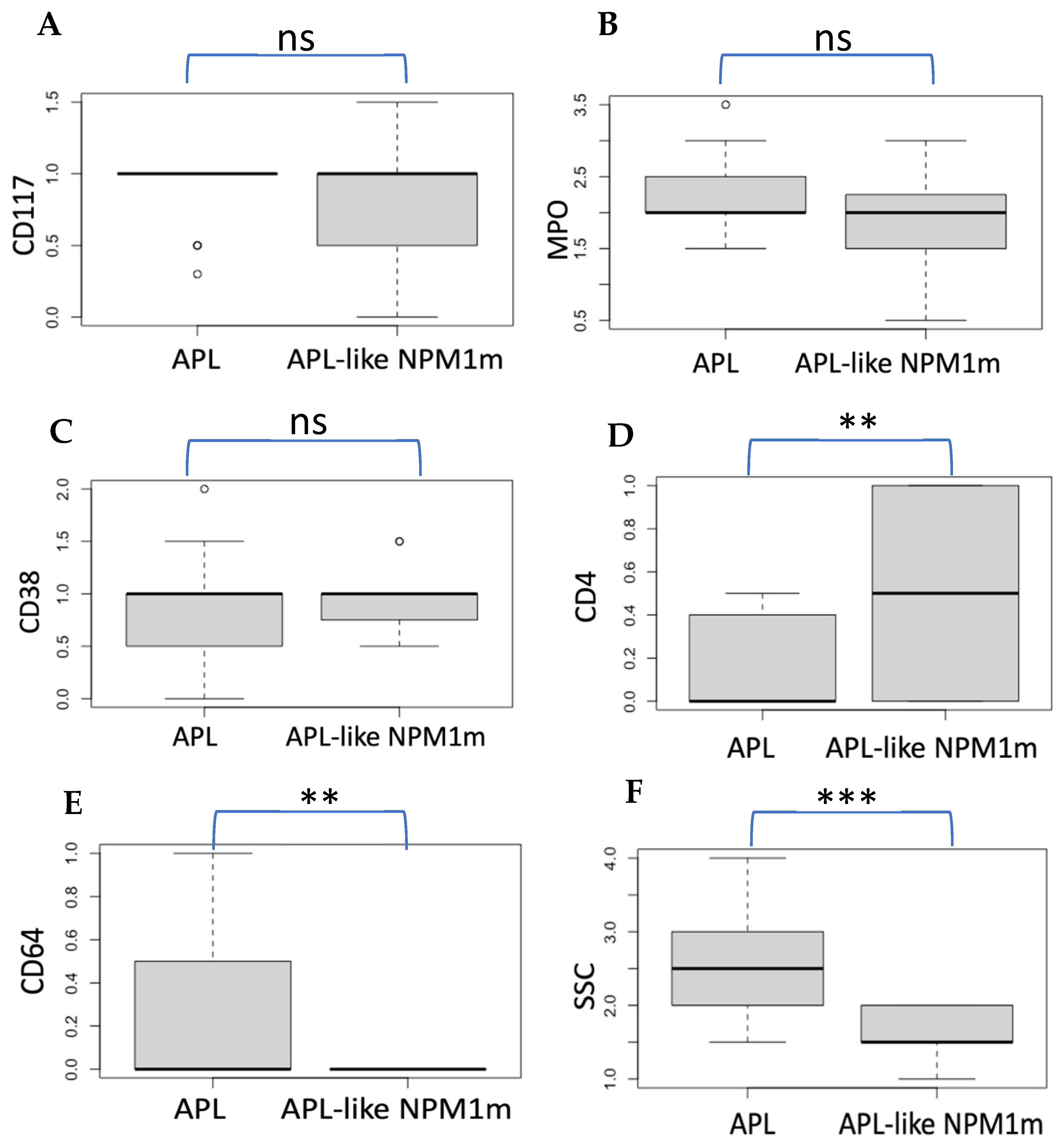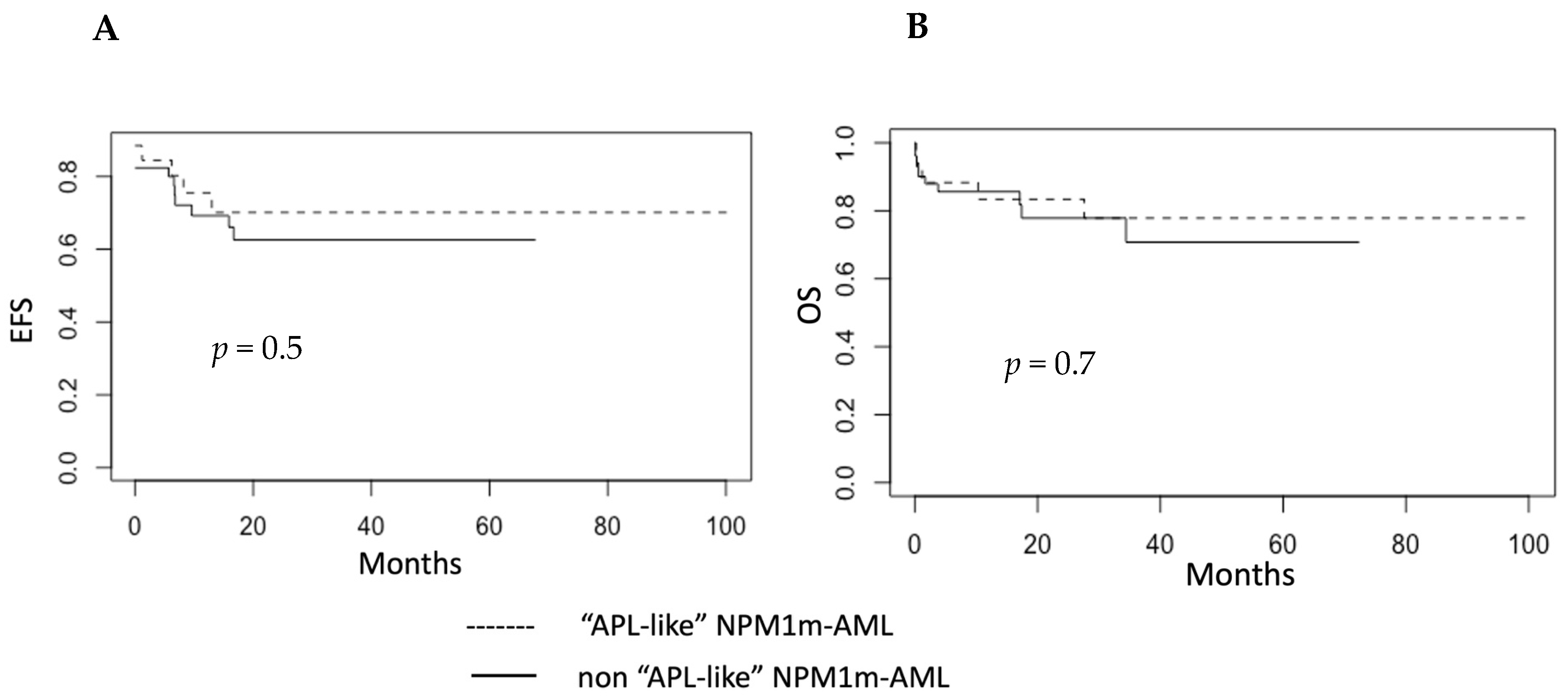Characteristics and Prognosis of “Acute Promyelocytic Leukemia-like” Nucleophosmin-1-Mutated Acute Myeloid Leukemia in a Retrospective Patient Cohort
Abstract
1. Introduction
2. Materials and Methods
2.1. Patients
2.2. Flow Cytometry
2.3. Oncogenetics Analyses
2.4. Statistical Analysis
3. Results
4. Discussion
Supplementary Materials
Author Contributions
Funding
Institutional Review Board Statement
Informed Consent Statement
Data Availability Statement
Conflicts of Interest
References
- Khoury, J.D.; Solary, E.; Abla, O.; Akkari, Y.; Alaggio, R.; Apperley, J.F.; Bejar, R.; Berti, E.; Busque, L.; Chan, J.K.C.; et al. The 5th edition of the World Health Organization Classification of Haematolymphoid Tumours: Myeloid and Histiocytic/Dendritic Neoplasms. Leukemia 2022, 36, 1703–1719. [Google Scholar] [CrossRef] [PubMed]
- Falini, B.; Brunetti, L.; Martelli, M.P. How I diagnose and treat NPM1-mutated AML. Blood 2021, 137, 589–599. [Google Scholar] [CrossRef] [PubMed]
- Zhao, D.; Zarif, M.; Eladl, E.; Capo-Chichi, J.M.; Smith, A.C.; Atenafu, E.G.; Tierens, A.; Minden, M.D.; Schuh, A.; Chang, H. NPM1-mutated AML-MRC diagnosed on the basis of history of MDS or MDS/MPN frequently harbours secondary-type mutations and confers inferior outcome compared to AML with mutated NPM1. Leuk. Res. 2022, 118, 106869. [Google Scholar] [CrossRef] [PubMed]
- Falini, B.; Brunetti, L.; Sportoletti, P.; Martelli, M.P. NPM1-mutated acute myeloid leukemia: From bench to bedside. Blood 2020, 136, 1707–1721. [Google Scholar] [CrossRef]
- Scott, D.D.; Oeffinger, M. Nucleolin and nucleophosmin: Nucleolar proteins with multiple functions in DNA repair. Biochem. Cell Biol. 2016, 94, 419–432. [Google Scholar] [CrossRef]
- Wang, X.Q.D.; Fan, D.; Han, Q.; Liu, Y.; Miao, H.; Wang, X.; Li, Q.; Chen, D.; Gore, H.; Himadewi, P.; et al. Mutant NPM1 Hijacks Transcriptional Hubs to Maintain Pathogenic Gene Programs in Acute Myeloid Leukemia. Cancer Discov. 2023, 13, 724–745. [Google Scholar] [CrossRef]
- Uckelmann, H.J.; Haarer, E.L.; Takeda, R.; Wong, E.M.; Hatton, C.; Marinaccio, C.; Perner, F.; Rajput, M.; Antonissen, N.J.C.; Wen, Y.; et al. Mutant NPM1 Directly Regulates Oncogenic Transcription in Acute Myeloid Leukemia. Cancer Discov. 2023, 13, 746–765. [Google Scholar] [CrossRef]
- Cheng, K.; Sportoletti, P.; Ito, K.; Clohessy, J.G.; Teruya-Feldstein, J.; Kutok, J.L.; Pandolfi, P.P. The cytoplasmic NPM mutant induces myeloproliferation in a transgenic mouse model. Blood 2010, 115, 3341–3345. [Google Scholar] [CrossRef]
- Sportoletti, P.; Grisendi, S.; Majid, S.M.; Cheng, K.; Clohessy, J.G.; Viale, A.; Teruya-Feldstein, J.; Pandolfi, P.P. Npm1 is a haploinsufficient suppressor of myeloid and lymphoid malignancies in the mouse. Blood 2008, 111, 3859–3862. [Google Scholar] [CrossRef]
- Muranyi, A.; Ammer, T.; Kechter, A.; Rawat, V.P.S.; Sinha, A.; Gonzalez-Menendez, I.; Quintanilla-Martinez, L.; Azoitei, A.; Gunes, C.; Mupo, A.; et al. Npm1 haploinsufficiency in collaboration with MEIS1 is sufficient to induce AML in mice. Blood Adv. 2023, 7, 351–364. [Google Scholar] [CrossRef]
- Papaemmanuil, E.; Gerstung, M.; Bullinger, L.; Gaidzik, V.I.; Paschka, P.; Roberts, N.D.; Potter, N.E.; Heuser, M.; Thol, F.; Bolli, N.; et al. Genomic Classification and Prognosis in Acute Myeloid Leukemia. N. Engl. J. Med. 2016, 374, 2209–2221. [Google Scholar] [CrossRef] [PubMed]
- Potter, N.; Miraki-Moud, F.; Ermini, L.; Titley, I.; Vijayaraghavan, G.; Papaemmanuil, E.; Campbell, P.; Gribben, J.; Taussig, D.; Greaves, M. Single cell analysis of clonal architecture in acute myeloid leukaemia. Leukemia 2019, 33, 1113–1123. [Google Scholar] [CrossRef] [PubMed]
- Duchmann, M.; Joudinaud, R.; Boudry, A.; Pasanisi, J.; Di Feo, G.; Kim, R.; Bucci, M.; Chauvel, C.; Chat, L.; Larcher, L.; et al. Hematopoietic differentiation at single-cell resolution in NPM1-mutated AML. Blood Cancer J. 2022, 12, 136. [Google Scholar] [CrossRef] [PubMed]
- Martelli, M.P.; Pettirossi, V.; Thiede, C.; Bonifacio, E.; Mezzasoma, F.; Cecchini, D.; Pacini, R.; Tabarrini, A.; Ciurnelli, R.; Gionfriddo, I.; et al. CD34+ cells from AML with mutated NPM1 harbor cytoplasmic mutated nucleophosmin and generate leukemia in immunocompromised mice. Blood 2010, 116, 3907–3922. [Google Scholar] [CrossRef] [PubMed]
- Taussig, D.C.; Vargaftig, J.; Miraki-Moud, F.; Griessinger, E.; Sharrock, K.; Luke, T.; Lillington, D.; Oakervee, H.; Cavenagh, J.; Agrawal, S.G.; et al. Leukemia-initiating cells from some acute myeloid leukemia patients with mutated nucleophosmin reside in the CD34− fraction. Blood 2010, 115, 1976–1984. [Google Scholar] [CrossRef]
- Dang, H.; Chen, Y.; Kamel-Reid, S.; Brandwein, J.; Chang, H. CD34 expression predicts an adverse outcome in patients with NPM1-positive acute myeloid leukemia. Hum. Pathol. 2013, 44, 2038–2046. [Google Scholar] [CrossRef]
- Pianigiani, G.; Rocchio, F.; Peruzzi, S.; Andresen, V.; Bigerna, B.; Sorcini, D.; Capurro, M.; Gjertsen, B.T.; Sportoletti, P.; Di Ianni, M.; et al. The absent/low expression of CD34 in NPM1-mutated AML is not related to cytoplasmic dislocation of NPM1 mutant protein. Leukemia 2022, 36, 1931–1934. [Google Scholar] [CrossRef]
- Mason, E.F.; Kuo, F.C.; Hasserjian, R.P.; Seegmiller, A.C.; Pozdnyakova, O. A distinct immunophenotype identifies a subset of NPM1-mutated AML with TET2 or IDH1/2 mutations and improved outcome. Am. J. Hematol. 2018, 93, 504–510. [Google Scholar] [CrossRef]
- Liu, Y.R.; Zhu, H.H.; Ruan, G.R.; Qin, Y.Z.; Shi, H.X.; Lai, Y.Y.; Chang, Y.; Wang, Y.Z.; Lu, D.; Hao, L.; et al. NPM1-mutated acute myeloid leukemia of monocytic or myeloid origin exhibit distinct immunophenotypes. Leuk. Res. 2013, 37, 737–741. [Google Scholar] [CrossRef]
- Falini, B.; Bigerna, B.; Pucciarini, A.; Tiacci, E.; Mecucci, C.; Morris, S.W.; Bolli, N.; Rosati, R.; Hanissian, S.; Ma, Z.; et al. Aberrant subcellular expression of nucleophosmin and NPM-MLF1 fusion protein in acute myeloid leukaemia carrying t(3;5): A comparison with NPMc+ AML. Leukemia 2006, 20, 368–371. [Google Scholar] [CrossRef]
- Martelli, M.P.; Rossi, R.; Venanzi, A.; Meggendorfer, M.; Perriello, V.M.; Martino, G.; Spinelli, O.; Ciurnelli, R.; Varasano, E.; Brunetti, L.; et al. Novel NPM1 exon 5 mutations and gene fusions leading to aberrant cytoplasmic nucleophosmin in AML. Blood 2021, 138, 2696–2701. [Google Scholar] [CrossRef] [PubMed]
- Ruminy, P.; Marchand, V.; Buchbinder, N.; Larson, T.; Joly, B.; Penther, D.; Lemasle, E.; Lepretre, S.; Angot, E.; Mareschal, S.; et al. Multiplexed targeted sequencing of recurrent fusion genes in acute leukaemia. Leukemia 2016, 30, 757–760. [Google Scholar] [CrossRef] [PubMed]
- Buradkar, A.; Bezerra, E.; Coltro, G.; Lasho, T.L.; Finke, C.M.; Gangat, N.; Carr, R.M.; Binder, M.; Mangaonkar, A.A.; Ketterling, R.; et al. Landscape of RAS pathway mutations in patients with myelodysplastic syndrome/myeloproliferative neoplasm overlap syndromes: A study of 461 molecularly annotated patients. Leukemia 2021, 35, 644–649. [Google Scholar] [CrossRef]
- Dohner, H.; Wei, A.H.; Appelbaum, F.R.; Craddock, C.; DiNardo, C.D.; Dombret, H.; Ebert, B.L.; Fenaux, P.; Godley, L.A.; Hasserjean, R.P.; et al. Diagnosis and management of AML in adults: 2022 recommendations from an international expert panel on behalf of the ELN. Blood 2022, 140, 1345–1377. [Google Scholar] [CrossRef] [PubMed]
- Corpas, F.J.; Barroso, J.B.; Sandalio, L.M.; Palma, J.M.; Lupiáñez, J.A.; del Río, L.A. Peroxisomal NADP-Dependent Isocitrate Dehydrogenase. Characterization and Activity Regulation during Natural Senescence. Plant Physiol. 1999, 121, 921–928. [Google Scholar] [CrossRef]
- Ploumakis, A.; Coleman, M.L. OH, the Places You’ll Go! Hydroxylation, Gene Expression, and Cancer. Mol. Cell 2015, 58, 729–741. [Google Scholar] [CrossRef]
- Dong, C.; Zhang, H.; Xu, C.; Arrowsmith, C.H.; Min, J. Structure and function of dioxygenases in histone demethylation and DNA/RNA demethylation. IUCrJ 2014, 1 Pt 6, 540–549. [Google Scholar] [CrossRef]
- Garrett-Bakelman, F.E.; Melnick, A.M. Mutant IDH: A targetable driver of leukemic phenotypes linking metabolism, epigenetics and transcriptional regulation. Epigenomics 2016, 8, 945–957. [Google Scholar] [CrossRef]
- Charlton, J.; Jung, E.J.; Mattei, A.L.; Bailly, N.; Liao, J.; Martin, E.J.; Giesselmann, P.; Brandl, B.; Stamenova, E.K.; Muller, F.J.; et al. TETs compete with DNMT3 activity in pluripotent cells at thousands of methylated somatic enhancers. Nat. Genet. 2020, 52, 819–827. [Google Scholar] [CrossRef]
- Ostrander, E.L.; Kramer, A.C.; Mallaney, C.; Celik, H.; Koh, W.K.; Fairchild, J.; Haussler, E.; Zhang, C.R.C.; Challen, G.A. Divergent Effects of Dnmt3a and Tet2 Mutations on Hematopoietic Progenitor Cell Fitness. Stem Cell Rep. 2020, 14, 551–560. [Google Scholar] [CrossRef]
- Arana Rosainz, M.J.; Nguyen, N.; Wahed, A.; Lelenwa, L.C.; Aakash, N.; Schaefer, K.; Rios, A.; Kanaan, Z.; Chen, L. Acute myeloid leukemia with mutated NPM1 mimics acute promyelocytic leukemia presentation. Int. J. Lab. Hematol. 2021, 43, 218–226. [Google Scholar] [CrossRef] [PubMed]
- Pepper, M.; Tan, B. Acute myeloid leukemia with NPM1 and FLT3 ITD mimicking acute promyelocytic leukemia. Blood 2020, 136, 1467. [Google Scholar] [CrossRef] [PubMed]
- Gajendra, S.; Gupta, R.; Thakral, D.; Gupta, S.K.; Jain, G.; Bakhshi, S.; Sharma, A.; Sahoo, R.K.; Kumar, L.; Rai, S.; et al. CD34 negative HLA-DR negative acute myeloid leukaemia: A higher association with NPM1 and FLT3-ITD mutations. Int. J. Lab. Hematol. 2023, 45, 221–228. [Google Scholar] [CrossRef] [PubMed]
- Crupi, F.; Ciolli, G.; Piccini, M.; Bencini, S.; Gianfaldoni, G.; Peruzzi, B.; Caporale, R.; Scappini, B.; Fasano, L.; Quinti, E.; et al. APL-like Subset within NPM1-Mutated Acute Myeloid Leukemia: A Distinct Phenotypic Signature Correlating with Early-Onset Vascular Complications. Blood 2023, 142, 4224–4226. [Google Scholar] [CrossRef]
- Liu, M.; Weng, X.; Gong, S.; Chen, H.; Ding, J.; Guo, M.; Hu, X.; Wang, J.; Yang, J.; Tang, G. Flow cytometric analysis of CD64 expression pattern and density in the diagnosis of acute promyelocytic leukemia: A multi-center study in Shanghai, China. Oncotarget 2017, 8, 80625–80637. [Google Scholar] [CrossRef]
- Fang, H.; Wang, S.A.; Hu, S.; Konoplev, S.N.; Mo, H.; Liu, W.; Zuo, Z.; Xu, J.; Jorgensen, J.L.; Yin, C.C.; et al. Acute promyelocytic leukemia: Immunophenotype and differential diagnosis by flow cytometry. Cytom. B Clin. Cytom. 2022, 102, 283–291. [Google Scholar] [CrossRef]
- Mason, E.F.; Hasserjian, R.P.; Aggarwal, N.; Seegmiller, A.C.; Pozdnyakova, O. Blast phenotype and comutations in acute myeloid leukemia with mutated NPM1 influence disease biology and outcome. Blood Adv. 2019, 3, 3322–3332. [Google Scholar] [CrossRef]
- Wang, B.; Yang, B.; Wu, W.; Liu, X.; Li, H. The correlation of next-generation sequencing-based genotypic profiles with clinicopathologic characteristics in NPM1-mutated acute myeloid leukemia. BMC Cancer 2021, 21, 788. [Google Scholar] [CrossRef]
- Papadopoulou, V.; Schoumans, J.; Basset, V.; Solly, F.; Pasquier, J.; Blum, S.; Spertini, O. Single-center, observational study of AML/MDS-EB with IDH1/2 mutations: Genetic profile, immunophenotypes, mutational kinetics and outcomes. Hematology 2023, 28, 2180704. [Google Scholar] [CrossRef]
- Dovey, O.M.; Cooper, J.L.; Mupo, A.; Grove, C.S.; Lynn, C.; Conte, N.; Andrews, R.M.; Pacharne, S.; Tzelepis, K.; Vijayabaskar, M.S.; et al. Molecular synergy underlies the co-occurrence patterns and phenotype of NPM1-mutant acute myeloid leukemia. Blood 2017, 130, 1911–1922. [Google Scholar] [CrossRef]
- Bezerra, M.F.; Lima, A.S.; Pique-Borras, M.R.; Silveira, D.R.; Coelho-Silva, J.L.; Pereira-Martins, D.A.; Weinhauser, I.; Franca-Neto, P.L.; Quek, L.; Corby, A.; et al. Co-occurrence of DNMT3A, NPM1, FLT3 mutations identifies a subset of acute myeloid leukemia with adverse prognosis. Blood 2020, 135, 870–875. [Google Scholar] [CrossRef] [PubMed]
- Issa, G.C.; Aldoss, I.; DiPersio, J.; Cuglievan, B.; Stone, R.; Arellano, M.; Thirman, M.J.; Patel, M.R.; Dickens, D.S.; Shenoy, S.; et al. The menin inhibitor revumenib in KMT2A-rearranged or NPM1-mutant leukaemia. Nature 2023, 615, 920–924. [Google Scholar] [CrossRef] [PubMed]
- Schlenk, R.F.; Dohner, K.; Kneba, M.; Gotze, K.; Hartmann, F.; Del Valle, F.; Kirchen, H.; Koller, E.; Fischer, J.T.; Bullinger, L.; et al. Gene mutations and response to treatment with all-trans retinoic acid in elderly patients with acute myeloid leukemia. Results from the AMLSG Trial AML HD98B. Haematologica 2009, 94, 54–60. [Google Scholar] [CrossRef] [PubMed]
- Schlenk, R.F.; Weber, D.; Krzykalla, J.; Kindler, T.; Wulf, G.; Hertenstein, B.; Salih, H.R.; Sudhoff, T.; Krauter, J.; Martens, U.; et al. Randomized phase-III study of low-dose cytarabine and etoposide +/− all-trans retinoic acid in older unfit patients with NPM1-mutated acute myeloid leukemia. Sci. Rep. 2023, 13, 14809. [Google Scholar] [CrossRef] [PubMed]
- Boutzen, H.; Saland, E.; Larrue, C.; de Toni, F.; Gales, L.; Castelli, F.A.; Cathebas, M.; Zaghdoudi, S.; Stuani, L.; Kaoma, T.; et al. Isocitrate dehydrogenase 1 mutations prime the all-trans retinoic acid myeloid differentiation pathway in acute myeloid leukemia. J. Exp. Med. 2016, 213, 483–497. [Google Scholar] [CrossRef]
- Fathi, A.T.; DiNardo, C.D.; Kline, I.; Kenvin, L.; Gupta, I.; Attar, E.C.; Stein, E.M.; de Botton, S.; AG221-C-001 Study Investigators. Differentiation Syndrome Associated With Enasidenib, a Selective Inhibitor of Mutant Isocitrate Dehydrogenase 2: Analysis of a Phase 1/2 Study. JAMA Oncol. 2018, 4, 1106–1110. [Google Scholar] [CrossRef]
- Montesinos, P.; Recher, C.; Vives, S.; Zarzycka, E.; Wang, J.; Bertani, G.; Heuser, M.; Calado, R.T.; Schuh, A.C.; Yeh, S.P.; et al. Ivosidenib and Azacitidine in IDH1-Mutated Acute Myeloid Leukemia. N. Engl. J. Med. 2022, 386, 1519–1531. [Google Scholar] [CrossRef]





| “APL-like” NPM1m (26) | “non-APL-like” NPM1m (51) | ||
|---|---|---|---|
| Age (median, range) | 61 (28–87) | 61 (35–86) | p = 0.67 |
| FLT3mut | 17/26 | 26/49 (2 not tested) | p = 0.43 |
| Allografted | 13/26 | 22/51 | p = 0.74 |
| Treatment | p = 0.67 | ||
| Chemo | 23 | 38 | |
| HMA+VEN | 1 | 3 | |
| HMA | 0 | 3 | |
| HMA+FLT3i | 0 | 1 | |
| Unknown | 0 | 1 | |
| None | 2 | 5 |
| APL (28) | “APL-like” NPM1m (26) | ||
|---|---|---|---|
| WBC (G/L) | 2.25 (0.4–69.6) | 53.25 (1.3–251.5) | p < 0.001 |
| Fibrinogen (g/L) | 1.5 (0.4–3.3) | 4.5 (0.9–9.6) | p < 0.001 |
| DD (mg/L) | 14.6 (2.3–80) | 9.4 (0.6–80) | p = 0.57 |
| DD/WBC | 5.44 (0.23–160) | 0.43 (0.04–4.92) | p < 0.001 |
| PT (sec) | 13.1 (11.3–22.1) | 11.7 (10.5–18.2) | p = 0.049 |
| PT/WBC | 4.83 (0.21–33.25) | 0.23 (0.06–8.54) | p < 0.001 |
Disclaimer/Publisher’s Note: The statements, opinions and data contained in all publications are solely those of the individual author(s) and contributor(s) and not of MDPI and/or the editor(s). MDPI and/or the editor(s) disclaim responsibility for any injury to people or property resulting from any ideas, methods, instructions or products referred to in the content. |
© 2024 by the authors. Licensee MDPI, Basel, Switzerland. This article is an open access article distributed under the terms and conditions of the Creative Commons Attribution (CC BY) license (https://creativecommons.org/licenses/by/4.0/).
Share and Cite
Papadopoulou, V.; Schiavini, G.; Stalder, G.; Basset, V.; Schoumans, J.; Nabergoj, M.; Schaller, M. Characteristics and Prognosis of “Acute Promyelocytic Leukemia-like” Nucleophosmin-1-Mutated Acute Myeloid Leukemia in a Retrospective Patient Cohort. Biomedicines 2024, 12, 2282. https://doi.org/10.3390/biomedicines12102282
Papadopoulou V, Schiavini G, Stalder G, Basset V, Schoumans J, Nabergoj M, Schaller M. Characteristics and Prognosis of “Acute Promyelocytic Leukemia-like” Nucleophosmin-1-Mutated Acute Myeloid Leukemia in a Retrospective Patient Cohort. Biomedicines. 2024; 12(10):2282. https://doi.org/10.3390/biomedicines12102282
Chicago/Turabian StylePapadopoulou, Vasiliki, Giulia Schiavini, Gregoire Stalder, Valentin Basset, Jacqueline Schoumans, Mitja Nabergoj, and Muriel Schaller. 2024. "Characteristics and Prognosis of “Acute Promyelocytic Leukemia-like” Nucleophosmin-1-Mutated Acute Myeloid Leukemia in a Retrospective Patient Cohort" Biomedicines 12, no. 10: 2282. https://doi.org/10.3390/biomedicines12102282
APA StylePapadopoulou, V., Schiavini, G., Stalder, G., Basset, V., Schoumans, J., Nabergoj, M., & Schaller, M. (2024). Characteristics and Prognosis of “Acute Promyelocytic Leukemia-like” Nucleophosmin-1-Mutated Acute Myeloid Leukemia in a Retrospective Patient Cohort. Biomedicines, 12(10), 2282. https://doi.org/10.3390/biomedicines12102282





